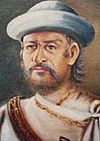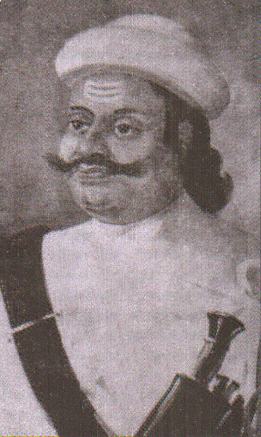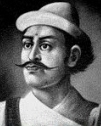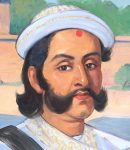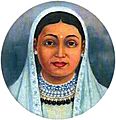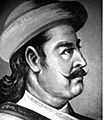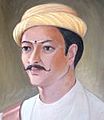Kshetri facts for kids
  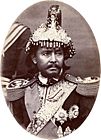
Up: Kalu Pande · Abhiman Singh Basnyat · Amar Singh Thapa
Bottom: Bhimsen Thapa · Balbhadra Kunwar · Jang Bahadur Rana |
|
| Total population | |
|---|---|
| 43,98,053 as per Nepal Census 2011 | |
| Regions with significant populations | |
| Languages | |
| Nepali language (Khas Kura) as mother tongue | |
| Religion | |
| Hinduism (99% approx.) with ancestral deity worship | |
| Related ethnic groups | |
| Bahun, Thakuri, Rajput |
The Kshetri or Chhetri (Nepali: क्षेत्री) are an important group of people in Nepal. They belong to the Kshatriya caste, which means they were traditionally warriors and rulers. Kshetris are part of the Khas people, an ancient group from the Himalayas.
These people are often called Khas Kshetris or Pahari Kshetris because they come from the hilly regions. For a long time, Kshetris played a big role in Nepal's history. They were leaders, government officials, and soldiers. They held many powerful positions in the government and military until 1951 AD. Even after democracy came to Nepal, Kshetris continued to be very active in politics and the army.
Contents
What Does Chhetri Mean?
The word "Chhetri" is a local Nepali term. It comes from the Sanskrit word "Kshatriya." This word refers to the warrior class in ancient Hindu society. People also use names like Hill-Kshetri, Pahadi Chhetri, or Khas Kshetri to describe this group.
A Look at Kshetri History
Kshetris are descendants of brave warriors from the old Khas Kingdom. They were very important in the military of the Shah dynasty, which ruled Nepal. Five main Kshetri families were very powerful in the royal court. These families were the Basnyat, Pande, Thapa, Kunwar, and Bista.
During the time Nepal was being unified, the Basnyat, Pande, and Thapa families were especially strong. They were led by famous figures like Shivaram Singh Basnyat, Kalu Pande, and Birbhadra Thapa. The Kunwars were led by Ramkrishna Kunwar, and the Bista family by Gajabal Bista and Atibal Bista.
There were often power struggles between these families. The Pande and Thapa families were big rivals. The Pandes usually had the support of the Basnyats. The Thapas were supported by the Kunwars. Eventually, the Kunwars rose to power. They even changed their family name from Kunwar to Rana, which means "King." This marked a new period of rule by the Rana family.
Where Do Kshetris Live?
According to the 2011 Nepal census, Kshetris are the largest group in Nepal. They make up about 16.6% of the country's population. This means there are over 4.3 million Kshetri people in Nepal.
Most Kshetris follow the Hindu religion. About 99.3% of Kshetris are Hindu. Kshetris are the biggest group in 20 districts across Nepal. The Kathmandu district has the largest number of Kshetri people.
Kshetris also have a strong presence in Nepal's government jobs. They make up about 19.59% of all civil servants. They are especially dominant in the military. Most high-ranking officers in the Nepali army are either Kshetri or Thakuri. This shows their continued influence in the country's defense.
Kshetri Culture and Traditions
Religious Practices
Almost all Kshetris are Hindus. They worship many Hindu gods and goddesses. They also honor their family deities, called Kul Devta, and other friendly deities. Kshetris often worship warrior goddesses like Bhadrakali and Kalika Bhawani. They also worship fierce forms of Lord Shiva, like Rudra and Veerbhadra.
Bhadrakali is a very important goddess for the Nepalese Army. Before battles, Kshetris would pray to these deities for strength and victory. There's a story that a Chinese attack in 1792 AD failed because of the powerful war cry, "Jai Bhawani!" This shows how important their faith was in times of war.
Many Kshetri families celebrate a special worship called Dewali Puja every three years. During this puja, people from the same clan offer male goats as sacrifices. This is a very old tradition that continues today. Kshetris also celebrate major Hindu festivals like Dashain, Tihar, Maghe Sankranti, and Holi. Dashain and Tihar are the most important festivals for them. During Dashain, many Kshetri families sacrifice goats or sometimes buffaloes.
Marriage Customs
Kshetris have specific rules about marriage. They generally marry within their own group, but not within their own clan or certain maternal family lines. This is to keep family ties strong and avoid marrying close relatives. For example, if a Kshetri has a maternal clan called Khilchine Adhikari, they cannot marry someone from the Khilchine Adhikari Bahun clan. This is because these clans are considered like brothers and sisters. They also never marry someone from their father's clan or someone with the same gotra (a traditional lineage system).
Dietary Habits
Kshetri people follow certain dietary rules. They do not eat pork, which is a key difference from some other groups. They also avoid beef, buffalo, and wild animals like felines. However, they are allowed to eat goats and sheep. Whether they eat chicken, duck, or goose can depend on the region they live in. These rules are based on their Hindu traditions.
Kshetri Values and Ethics
Historically, Kshetris were part of powerful empires like the Khas Empire and the Gorkha Empire. They are known for being brave warriors, good leaders, and honest administrators. They are also seen as resourceful and charitable.
Their values come from ancient Hindu texts like the Bhagavad Gita. This text talks about the duties of a Kshatriya warrior. It explains that they should be brave, skillful, never run from a battle, be generous, and govern fairly. Kshetris have adopted these values, which guide their actions and behavior.
Common Kshetri Family Names
Many Kshetri families use specific surnames. Some of the common ones include: Adhikari, Bagale, Baruwal, Bohara, Basnyat/Basnet, Bhandari, Bista/Bisht, Budha, Budhathoki, Chauhan, Chhetri, Deoja, Godar, Kalikote, Karki, Katawal, Kadayat, Kathayat, Khadka, Khatri/Khatri Chhetri (K.C.), Khulal, Kshetri, Mahat, Mahatara, Pande/Pandey, Punwar, Kunwar Rana, Gorkha Ko Rana, Ranabhat, Rathor, Raut/Rawat, Rawal, Rayamajhi, Rokaya/Rokka, Silwal, Suyal, Tandon, Thapa, and others.
Gallery
Images for kids



